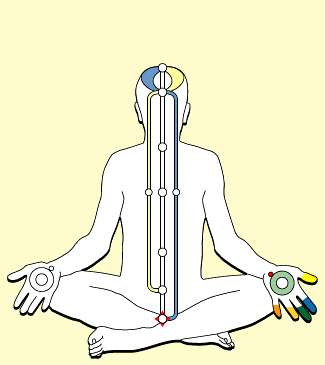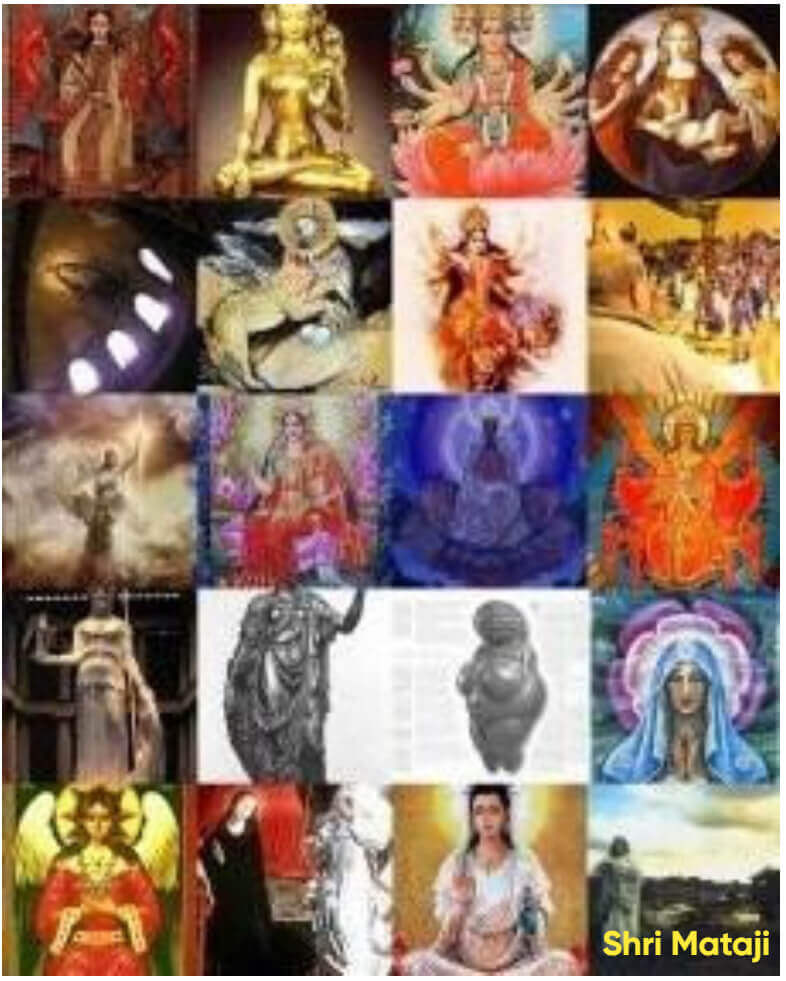Awakening The Kundalini
In this sacred reflection, the seeker is called to awaken the dormant serpent of Kundalini through the vibrational power of Siddha mantras and the grace of the Divine Mother. This initiation is not a ritual—it is a remembrance. As the inner Shakti rises, illusions fall away, and the soul ascends toward Brahman-Consciousness. The Divine Feminine does not demand belief; She offers experience. In Her embrace, the seeker discovers that liberation was never distant, and paradise was never lost—it has always pulsed within.
Abstract
This paper investigates the phenomenon of Kundalini awakening as articulated in the teachings of Shri Mataji Nirmala Devi, with a specific focus on the tangible experience of a 'Cool Breeze' (also referred to as Chi or Prana) as evidence of this spiritual event. By analyzing Shri Mataji's own words from primary sources, this paper elucidates her distinction between ritualistic practices and the 'actualization' of spiritual ascent. Furthermore, it situates these claims within a broader academic and scientific context, drawing upon recent studies in neuroscience, psychology, and physiology that explore spiritually transformative experiences. The paper argues that the 'Cool Breeze' phenomenon represents a critical nexus between subjective spiritual testimony and objective physiological correlates, offering a promising avenue for the interdisciplinary study of consciousness.
1. Introduction

The concept of Kundalini, a Sanskrit term meaning 'coiled one,' refers to a form of divine feminine energy believed to be located at the base of the spine. In many Eastern spiritual traditions, the awakening of this energy and its ascent through the central channel of the body, piercing the six chakras to unite with the universal consciousness in the seventh (Sahasrara), is considered the ultimate goal of human evolution. While often shrouded in esoteric language, the teachings of Shri Mataji Nirmala Devi present this profound experience as a tangible and verifiable event, accessible to all. Central to her claim is the physical sensation of a 'Cool Breeze' felt on the palms of the hands and, most significantly, from the fontanel bone area on top of the head.
This paper will analyze the core tenets of Shri Mataji's teachings on Kundalini awakening, using her direct quotations as primary evidence. It will then explore the significance of the 'Cool Breeze' as a phenomenological marker of this event. Finally, it will connect these spiritual claims to the growing body of scientific research on the physiological and neurological effects of meditation and spiritually transformative experiences, arguing that Shri Mataji's framework provides a unique and testable model for understanding the mind-body-spirit connection.
2. The Teachings of Shri Mataji: Actualization over Ritual
A central theme in Shri Mataji's discourse is the sharp distinction between empty religious rituals and the genuine, living experience of spiritual awakening. She critiques the superficiality of practices that do not result in a tangible inner transformation. As she states:
For Shri Mataji, the 'actualization' of baptism is synonymous with Kundalini awakening. This is not a symbolic act but a concrete event with a perceptible outcome. She emphasizes that this is a living process, a 'miracle' that can be directly experienced:
This assertion moves the concept of spiritual awakening from the realm of abstract belief into the domain of empirical, personal verification. The 'Cool Breeze' is presented not as a metaphor, but as the definitive evidence of the Kundalini's ascent and the establishment of a connection with the divine.
3. The 'Cool Breeze' as a Phenomenological Marker
The sensation of a 'Cool Breeze' (Chi) is the cornerstone of Shri Mataji's claim to have made Kundalini awakening a mass phenomenon. This experience, which she equates with the Chi of Chinese tradition and the Prana of yogic philosophy, serves as a tangible bio-feedback mechanism, confirming the awakening of the inner spiritual energy. The source material explicitly links this sensation to the Holy Ghost, indicating a universal spiritual principle that transcends cultural and religious boundaries.
The specificity of the sensation—a cool, gentle wind flowing from the fontanel bone area (the Brahmarandhra in yogic terminology)—is significant. This area corresponds to the Sahasrara chakra, the 'thousand-petalled lotus' that represents the pinnacle of human consciousness. The opening of this chakra and the subsequent flow of the 'Cool Breeze' signifies the union of the individual consciousness with the all-pervading power of divine love.
4. Scientific and Cross-Cultural Context
While the language used by Shri Mataji is spiritual, the phenomena she describes are increasingly being explored within the scientific community. Research into spiritually transformative experiences (STEs) has begun to document the profound physiological and psychological changes that accompany them. A study by Woollacott et al. (2021) found that 85% of participants reporting STEs described "unusual flows of energy through or around the body," a description that aligns closely with the experience of Kundalini. [2] The study also noted that these experiences often led to lasting positive changes, including increased sensory sensitivity, creativity, and a sense of unity with all life.
From a clinical perspective, the awakening of Kundalini can manifest in a variety of physical and psychological signs. Sharma et al. (2022) describe sensations such as "feeling currents of prana (vital energy) rising," "feeling electric-like currents flow up and down the nerves," and significant thermal changes in the body, where a chakra becomes "very cold" after the Kundalini has passed through it. [3] This description of a 'cold' sensation provides an interesting parallel to Shri Mataji's 'Cool Breeze'.
Neurological studies have also begun to identify the brain activity associated with these states. Research has pointed to activation in the left prefrontal cortex during Kundalini experiences and measurable changes in EEG patterns during deep meditation. [4] While this research is still in its early stages, it suggests that the subjective experiences of spiritual awakening have objective, measurable correlates in the brain and nervous system.
5. Discussion
The teachings of Shri Mataji provide a compelling framework for understanding Kundalini awakening as a verifiable phenomenon. By emphasizing the tangible sensation of the 'Cool Breeze', she demystifies the process and offers a method for individuals to confirm their own spiritual progress. This approach bridges the gap between esoteric spiritual concepts and direct, personal experience.
The convergence of her descriptions with findings from contemporary scientific research is remarkable. The 'flows of energy,' 'electric-like currents,' and 'cold' sensations documented in academic literature resonate strongly with the experience of the 'Cool Breeze' or Chi. This suggests that we are observing a universal human phenomenon, described in different languages but pointing to the same underlying reality. The challenge for science is to develop the tools and methodologies to study these subtle energy phenomena without reducing them to mere epiphenomena of brain activity.
6. Conclusion
Shri Mataji's articulation of Kundalini awakening, centered on the verifiable experience of the 'Cool Breeze,' offers a significant contribution to the global understanding of spirituality. Her teachings provide a practical and accessible method for achieving a state of higher consciousness, one that is not dependent on blind faith but is grounded in direct, perceptible evidence. The alignment of these teachings with emerging scientific research on the physiology of spiritual experiences suggests that a new paradigm for understanding consciousness—one that integrates the spiritual and the scientific—is not only possible but necessary. Future research should focus on longitudinal studies of individuals who have experienced Kundalini awakening, using a combination of phenomenological interviews, neuroimaging, and physiological measurements to further explore the profound implications of this transformative process.
References
- Adishakti.org Awakening The Kundalini.
- Woollacott, M. H., Kason, Y., & Park, R. D. (2021). Investigation of the phenomenology, physiology and impact of spiritually transformative experiences – kundalini awakening.
- Sharma, M., Dhankar, M., & Kumar, D. (2022). Awakening of Kundalini Chakras Presenting as Psychosis—A Case Report. Indian Journal of Psychological Medicine, 44(5), 526-528.
- Modestino, E. J. (2016). Neurophenomenology of an Altered State of Consciousness: The Kundalini Experience. Explore, 12(3), 195-202.


